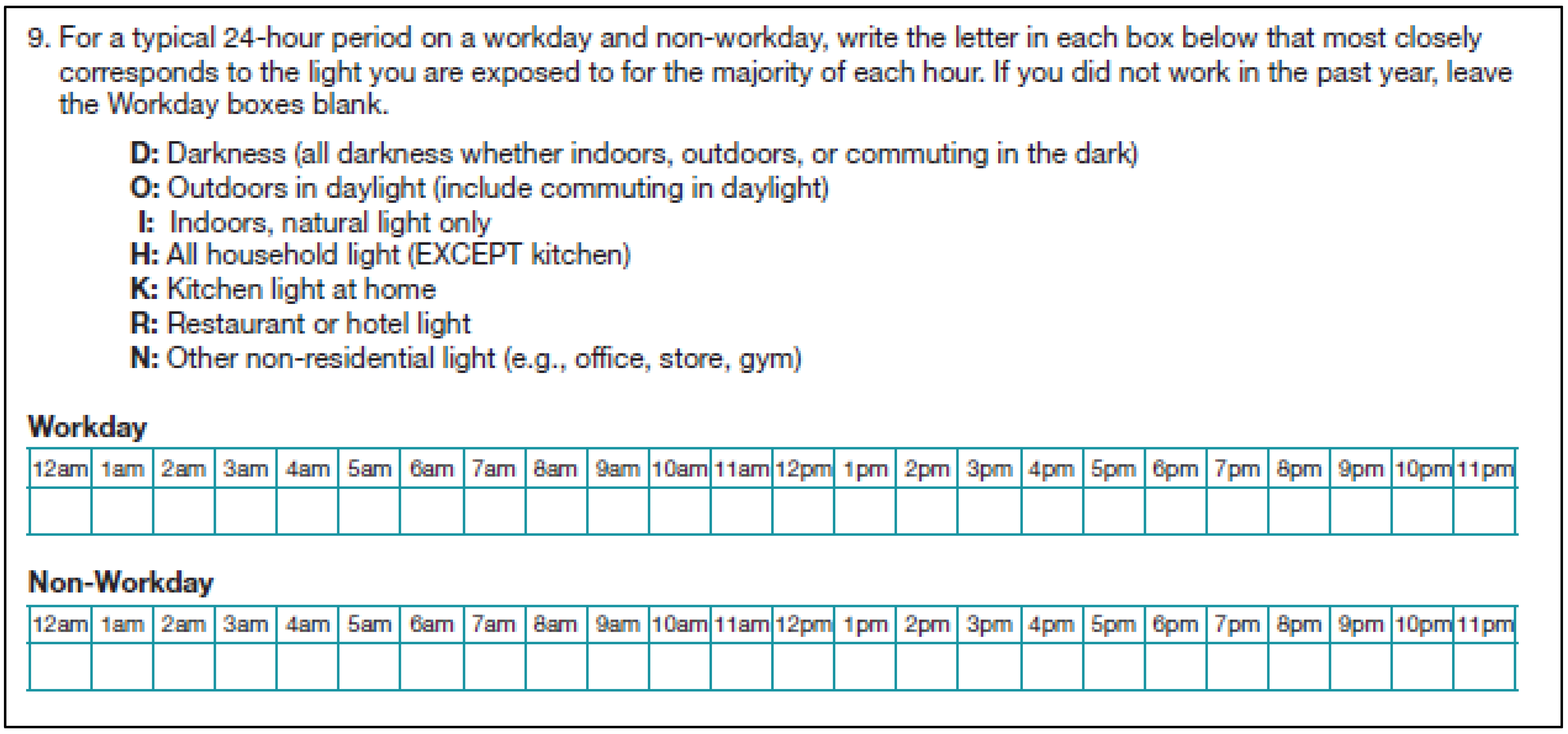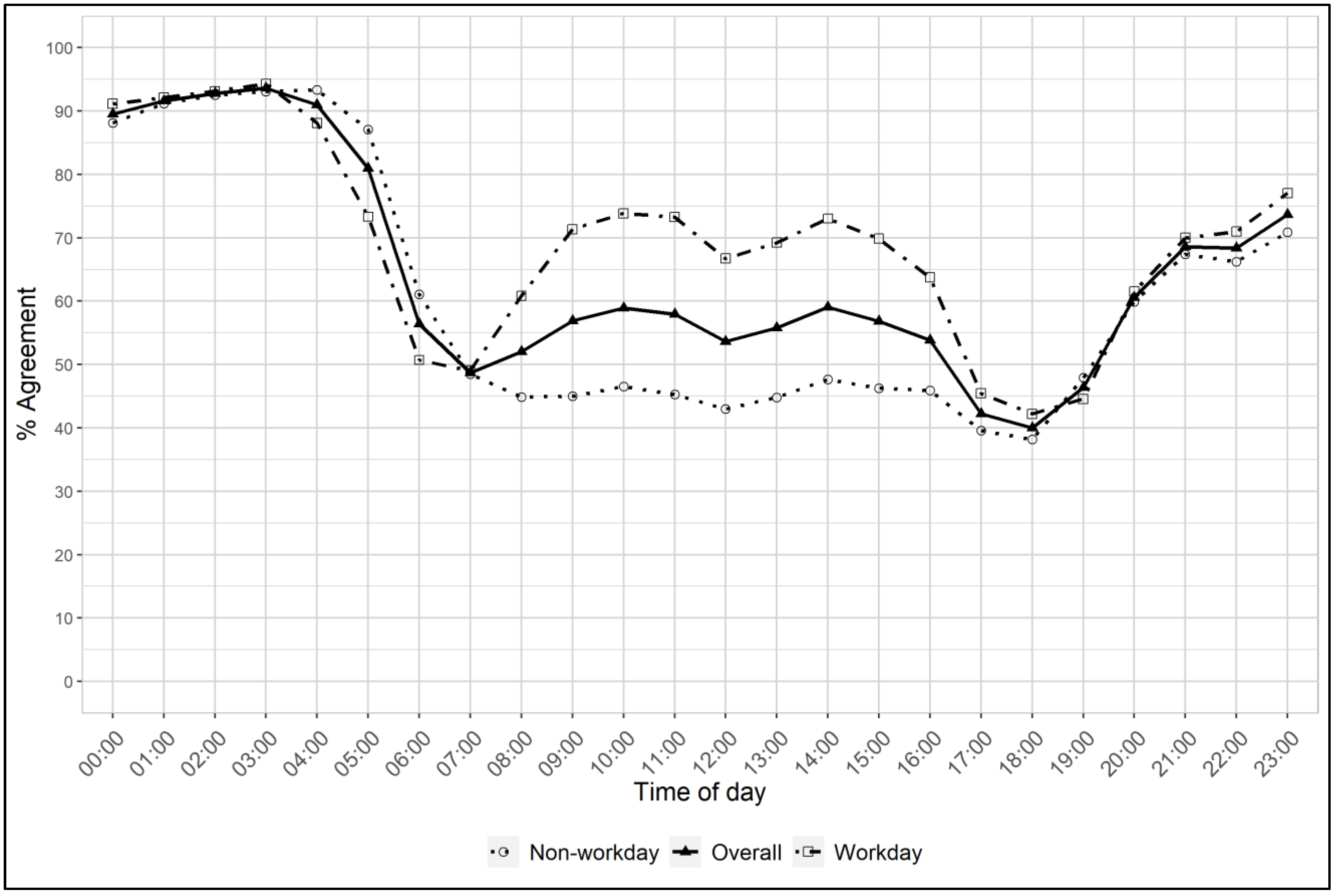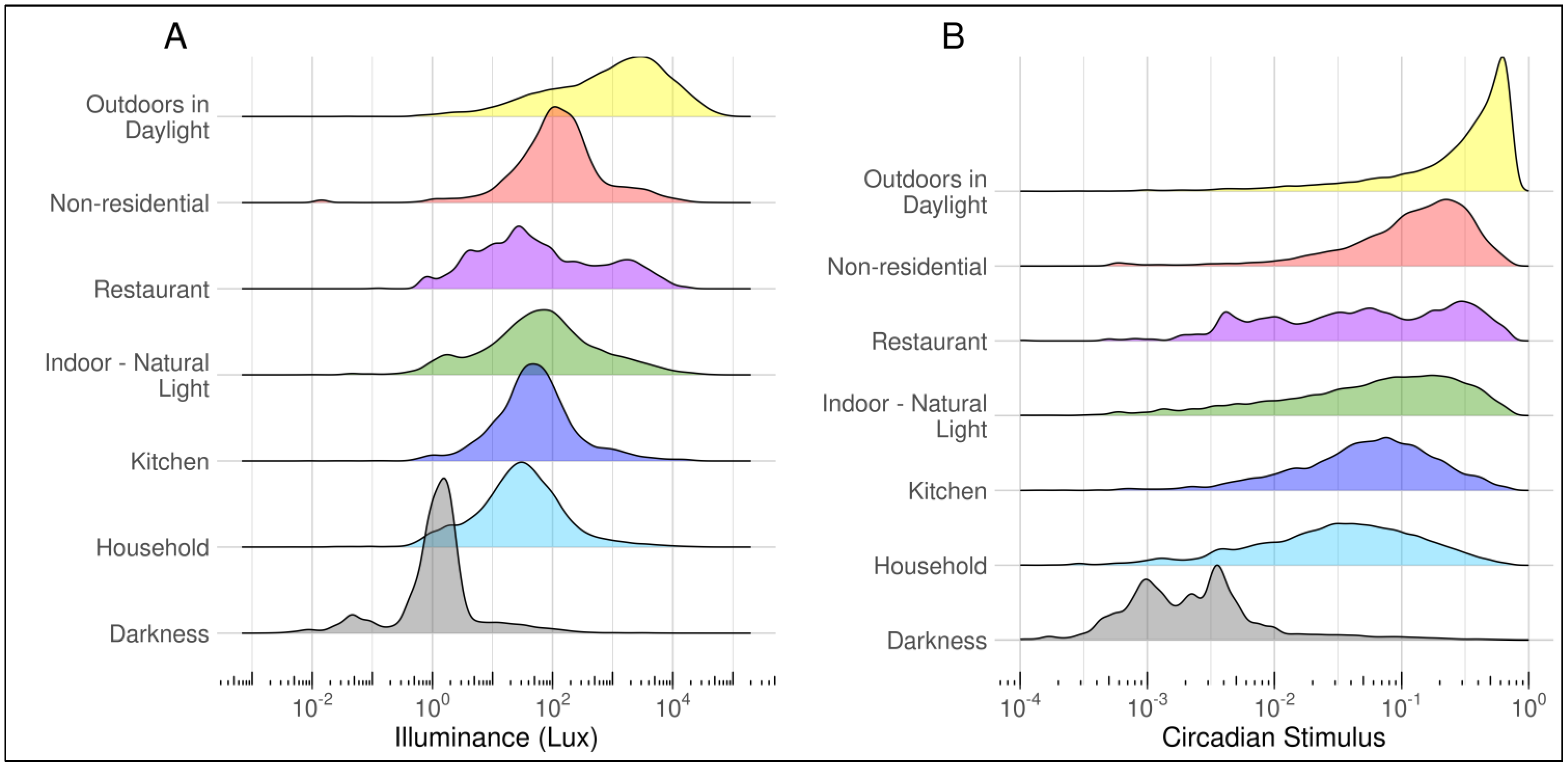Evaluation of a Novel Ambient Light Survey Question in the Cancer Prevention Study-3
Abstract
:1. Introduction
2. Materials and Methods
2.1. Study Population
2.2. Ambient Light Survey Questions
2.3. Measurement of Ambient Light
2.4. Statistical Analysis
3. Results
4. Discussion
5. Conclusions
Supplementary Materials
Author Contributions
Funding
Institutional Review Board Statement
Informed Consent Statement
Data Availability Statement
Acknowledgments
Conflicts of Interest
References
- Lunn, R.M.; Blask, D.E.; Coogan, A.N.; Figueiro, M.G.; Gorman, M.R.; Hall, J.E.; Hansen, J.; Nelson, R.J.; Panda, S.; Smolensky, M.H.; et al. Health consequences of electric lighting practices in the modern world: A report on the National Toxicology Program’s workshop on shift work at night, artificial light at night, and circadian disruption. Sci. Total Environ. 2017, 607–608, 1073–1084. [Google Scholar] [CrossRef] [Green Version]
- Kecklund, G.; Axelsson, J. Health consequences of shift work and insufficient sleep. BMJ 2016, 355, i5210. [Google Scholar] [CrossRef] [PubMed]
- Haus, E.L.; Smolensky, M.H. Shift work and cancer risk: Potential mechanistic roles of circadian disruption, light at night, and sleep deprivation. Sleep Med. Rev. 2013, 17, 273–284. [Google Scholar] [CrossRef]
- Fekry, B.; Eckel-Mahan, K. The circadian clock and cancer: Links between circadian disruption and disease Pathology. J. Biochem. 2022, 171, 477–486. [Google Scholar] [CrossRef] [PubMed]
- Lopes-Júnior, L.C.; Veronez, L.C. Circadian rhythms disruption in cancer. Biol. Rhythm. Res. 2022, 53, 1382–1399. [Google Scholar] [CrossRef]
- Samuelsson, L.B.; Bovbjerg, D.H.; Roecklein, K.A.; Hall, M.H. Sleep and circadian disruption and incident breast cancer risk: An evidence-based and theoretical review. Neurosci. Biobehav. Rev. 2018, 84, 35–48. [Google Scholar] [CrossRef] [PubMed]
- Stevens, R.G.; Blask, D.E.; Brainard, G.C.; Hansen, J.; Lockley, S.W.; Provencio, I.; Rea, M.S.; Reinlib, L. Meeting report: The role of environmental lighting and circadian disruption in cancer and other diseases. Environ. Health Perspect. 2007, 115, 1357–1362. [Google Scholar] [CrossRef] [Green Version]
- IARC. Working Group on the Evaluation of Carinogenic Risks to Humans Painting, Firefighting, and Shiftwork; International Agency for Research on Cancer: Lyon, France, 2007. [Google Scholar]
- Sigurdardottir, L.G.; Valdimarsdottir, U.A.; Fall, K.; Rider, J.R.; Lockley, S.W.; Schernhammer, E.; Mucci, L.A. Circadian disruption, sleep loss, and prostate cancer risk: A systematic review of epidemiologic studies. Cancer Epidemiol. Biomark. Prev. 2012, 21, 1002–1011. [Google Scholar] [CrossRef] [Green Version]
- Travis, R.C.; Balkwill, A.; Fensom, G.K.; Appleby, P.N.; Reeves, G.K.; Wang, X.S.; Roddam, A.W.; Gathani, T.; Peto, R.; Green, J.; et al. Night Shift Work and Breast Cancer Incidence: Three Prospective Studies and Meta-analysis of Published Studies. J. Natl. Cancer Inst. 2016, 108, djw169. [Google Scholar] [CrossRef]
- Wendeu-Foyet, M.G.; Menegaux, F. Circadian Disruption and Prostate Cancer Risk: An Updated Review of Epidemiological Evidences. Cancer Epidemiol. Biomark. Prev. 2017, 26, 985–991. [Google Scholar] [CrossRef] [Green Version]
- IARC. Monographs Vol 124 Group, Carcinogenicity of night shift work. Lancet Oncol. 2019, 20, 1058–1059. [Google Scholar] [CrossRef] [PubMed]
- Bajaj, A.; Rosner, B.; Lockley, S.W.; Schernhammer, E.S. Validation of a light questionnaire with real-life photopic illuminance measurements: The Harvard Light Exposure Assessment questionnaire. Cancer Epidemiol. Biomark. Prev. 2011, 20, 1341–1349. [Google Scholar] [CrossRef] [PubMed] [Green Version]
- Illuminating Engineering Society IES Lighting Library. Available online: https://www.ies.org/standards/ies-lighting-library/ (accessed on 31 March 2020).
- Rea, M.S. IESNA Lighting Handbook: Reference and Application, 9th ed.; Illuminating Engineering Society of North America: New York, NY, USA, 2000. [Google Scholar]
- Patel, A.V.; Jacobs, E.J.; Dudas, D.M.; Briggs, P.J.; Lichtman, C.J.; Bain, E.B.; Stevens, V.L.; McCullough, M.L.; Teras, L.R.; Campbell, P.T.; et al. The American Cancer Society’s Cancer Prevention Study 3 (CPS-3): Recruitment, study design, and baseline characteristics. Cancer 2017, 123, 2014–2024. [Google Scholar] [CrossRef] [PubMed] [Green Version]
- Figueiro, M.G.; Hamner, R.; Bierman, A.; Rea, M.S. Comparisons of three practical field devices used to measure personal light exposures and activity levels. Light Res. Technol. 2013, 45, 421–434. [Google Scholar] [CrossRef]
- Lighting Research Center the Daysimeter. Available online: http://www.lrc.rpi.edu/programs/lightHealth/LightandDaysimeter.asp (accessed on 26 November 2017).
- Miller, D.; Bierman, A.; Figueiro, M.; Schernhammer, E.; Rea, M. Ecological measurements of light exposure, activity, and circadian disruption. Light Res. Technol. 2010, 42, 271–284. [Google Scholar] [CrossRef] [Green Version]
- Rea, M.S.; Figueiro, M.G.; Bierman, A.; Bullough, J.D. Circadian light. J. Circadian Rhythm. 2010, 8, 2. [Google Scholar] [CrossRef] [Green Version]
- Brown, T.M.; Brainard, G.C.; Cajochen, C.; Czeisler, C.A.; Hanifin, J.P.; Lockley, S.W.; Lucas, R.J.; Munch, M.; O’Hagan, J.B.; Peirson, S.N.; et al. Recommendations for daytime, evening, and nighttime indoor light exposure to best support physiology, sleep, and wakefulness in healthy adults. PLoS Biol. 2022, 20, e3001571. [Google Scholar] [CrossRef]
- Hattar, S.; Lucas, R.J.; Mrosovsky, N.; Thompson, S.; Douglas, R.H.; Hankins, M.W.; Lem, J.; Biel, M.; Hofmann, F.; Foster, R.G.; et al. Melanopsin and rod-cone photoreceptive systems account for all major accessory visual functions in mice. Nature 2003, 424, 76–81. [Google Scholar] [CrossRef] [Green Version]
- Matynia, A.; Parikh, S.; Chen, B.; Kim, P.; McNeill, D.S.; Nusinowitz, S.; Evans, C.; Gorin, M.B. Intrinsically photosensitive retinal ganglion cells are the primary but not exclusive circuit for light aversion. Exp. Eye Res. 2012, 105, 60–69. [Google Scholar] [CrossRef]
- Mure, L.S.; Vinberg, F.; Hanneken, A.; Panda, S. Functional diversity of human intrinsically photosensitive retinal ganglion cells. Science 2019, 366, 1251–1255. [Google Scholar] [CrossRef]
- Rea, M.S.; Nagare, R.; Figueiro, M.G. Modeling Circadian Phototransduction: Retinal Neurophysiology and Neuroanatomy. Front. Neurosci. 2020, 14, 615305. [Google Scholar] [CrossRef] [PubMed]
- Rea, M.S.; Nagare, R.; Figueiro, M.G. Modeling Circadian Phototransduction: Quantitative Predictions of Psychophysical Data. Front. Neurosci. 2021, 15, 615322. [Google Scholar] [CrossRef]
- Ruby, N.F.; Brennan, T.J.; Xie, X.; Cao, V.; Franken, P.; Heller, H.C.; O’Hara, B.F. Role of melanopsin in circadian responses to light. Science 2002, 298, 2211–2213. [Google Scholar] [CrossRef]
- McHugh, M.L. Interrater reliability: The kappa statistic. Biochem. Med. 2012, 22, 276–282. [Google Scholar] [CrossRef]
- Hastie, T.; Tibshirani, R.; Friedman, J. The Elements of Statistical Learning: Data Mining, Inference, and Prediction, 2nd ed.; Springer: New York, NY, USA, 2009; pp. 241–248. [Google Scholar]
- Bakdash, J.Z.; Marusich, L.R. Repeated Measures Correlation. Front. Psychol. 2017, 8, 456. [Google Scholar] [CrossRef] [PubMed] [Green Version]
- Fu, W.J.; Carroll, R.J.; Wang, S. Estimating misclassification error with small samples via bootstrap cross-validation. Bioinformatics 2005, 21, 1979–1986. [Google Scholar] [CrossRef] [Green Version]
- Koo, T.K.; Li, M.Y. A Guideline of Selecting and Reporting Intraclass Correlation Coefficients for Reliability Research. J. Chiropr. Med. 2016, 15, 155–163. [Google Scholar] [CrossRef] [Green Version]
- Cust, A.E.; Fenton, G.L.; Smit, A.K.; Espinoza, D.; Dobbinson, S.; Brodie, A.; Dang, H.T.C.; Kimlin, M.G. Validation of Questionnaire and Diary Measures of Time Outdoors Against an Objective Measure of Personal Ultraviolet Radiation Exposure. Photochem. Photobiol. 2018, 94, 815–820. [Google Scholar] [CrossRef] [PubMed]
- Thieden, E.; Agren, M.S.; Wulf, H.C. Solar UVR exposures of indoor workers in a Working and a Holiday Period assessed by personal dosimeters and sun exposure diaries. Photodermatol. Photoimmunol. Photomed. 2001, 17, 249–255. [Google Scholar] [CrossRef]
- Troeschel, A.N.; Hartman, T.J.; Flanders, W.D.; Wang, Y.; Hodge, R.A.; McCullough, L.E.; Mitchell, D.C.; Sampson, L.; Patel, A.V.; McCullough, M.L. The American Cancer Society Cancer Prevention Study-3 FFQ Has Reasonable Validity and Reproducibility for Food Groups and a Diet Quality Score. J. Nutr. 2020, 150, 1566–1578. [Google Scholar] [CrossRef]
- Rees-Punia, E.; Matthews, C.E.; Evans, E.M.; Keadle, S.K.; Anderson, R.L.; Gay, J.L.; Schmidt, M.D.; Gapstur, S.M.; Patel, A.V. Demographic-specific Validity of the Cancer Prevention Study-3 Sedentary Time Survey. Med. Sci. Sports Exerc. 2019, 51, 41–48. [Google Scholar] [CrossRef]
- Figueiro, M.G.; Rea, M.S. Office lighting and personal light exposures in two seasons: Impact on sleep and mood. Light. Res. Technol. 2016, 48, 352. [Google Scholar] [CrossRef]
- Underwriters Laboratories Inc. Design Guideline for Promoting Circadian Entrainment with Light for Day-Active People. In Design Guideline 24480; Underwriters Laboratories, Inc.: Northbrook, IL, USA, 2019. [Google Scholar]
- Figueiro, M.G.; Steverson, B.; Heerwagen, J.; Kampschroer, K.; Hunter, C.M.; Gonzales, K.; Plitnick, B.; Rea, M.S. The impact of daytime light exposures on sleep and mood in office workers. Sleep Health 2017, 3, 204–215. [Google Scholar] [CrossRef] [PubMed]
- Rea, M.S.; Nagare, R.; Figueiro, M.G. Predictions of melatonin suppression during the early biological night and their implications for residential light exposures prior to sleeping. Sci. Rep. 2020, 10, 14114. [Google Scholar] [CrossRef]
- Hunter, C.M.; Figueiro, M.G. Measuring Light at Night and Melatonin Levels in Shift Workers: A Review of the Literature. Biol. Res. Nurs. 2017, 19, 365–374. [Google Scholar] [CrossRef]
- Glanz, K.; Gies, P.; O’Riordan, D.L.; Elliott, T.; Nehl, E.; McCarty, F.; Davis, E. Validity of self-reported solar UVR exposure compared with objectively measured UVR exposure. Cancer Epidemiol. Biomark. Prev. 2010, 19, 3005–3012. [Google Scholar] [CrossRef] [PubMed] [Green Version]
- Flagg, E.W.; Coates, R.J.; Calle, E.E.; Potischman, N.; Thun, M.J. Validation of the American Cancer Society Cancer Prevention Study II Nutrition Survey Cohort Food Frequency Questionnaire. Epidemiology 2000, 11, 462–468. [Google Scholar] [CrossRef] [PubMed]



| Annual Surveys and Diaries (N = 732) | Daysimeter (N = 170) | |||
|---|---|---|---|---|
| Characteristic 1 | Men | Women | Men | Women |
| N | 296 | 436 | 86 | 84 |
| Age, mean (SD) | 49.1 (10.1) | 48.1 (9.7) | 49.0 (10.4) | 47.5 (8.8) |
| Race | ||||
| Black | 52 (17.6) | 88 (20.2) | 17 (19.8) | 17 (20.2) |
| Hispanic | 43 (14.5) | 67 (15.4) | 17 (19.8) | 15 (17.9) |
| White | 201 (67.9) | 281 (64.4) | 52 (60.5) | 52 (61.9) |
| Marital Status | ||||
| Married | 201 (67.9) | 264 (60.6) | 60 (69.8) | 50 (59.5) |
| Not Married | 42 (14.2) | 116 (26.6) | 14 (16.3) | 18 (21.4) |
| Missing | 53 (17.9) | 56 (12.8) | 12 (14.0) | 16 (19.0) |
| Education | ||||
| <College | 52 (17.6) | 106 (24.3) | 19 (22.1) | 17 (20.2) |
| College + | 191 (64.5) | 275 (63.1) | 53 (61.6) | 51 (60.7) |
| Missing | 53 (17.9) | 55 (12.6) | 14 (16.3) | 16 (19.0) |
| Number of Jobs | ||||
| 0 | 52 (17.6) | 80 (18.3) | 22 (25.6) | 10 (11.9) |
| 1 | 213 (72.0) | 296 (67.9) | 55 (63.9) | 58 (69.0) |
| 2 | 26 (8.8) | 53 (12.2) | 9 (10.5) | 14 (16.7) |
| 3+ | 5 (1.7) | 7 (1.6) | - | - |
| Shift Type | ||||
| Day Shift Only | 219 (74.0) | 337 (77.3) | 59 (68.6) | 66 (78.6) |
| Rotating Shift | 15 (5.1) | 13 (3.0) | 4 (4.7) | 4 (4.8) |
| Night Shift Only | 10 (3.4) | 6 (1.4) | 1 (1.2) | 3 (3.6) |
| Not working | 52 (17.6) | 80 (18.3) | 22 (25.6) | 10 (11.9) |
| Region | ||||
| Northeast | 59 (19.9) | 55 (12.6) | 15 (17.4) | 14 (16.7) |
| South | 106 (35.8) | 152 (34.9) | 38 (44.2) | 32 (38.1) |
| Midwest | 89 (30.1) | 147 (33.7) | 22 (25.6) | 29 (34.5) |
| West | 42 (14.2) | 82 (18.8) | 11 (12.8) | 9 (10.7) |
| Pre- vs. Post-Annual Surveys 1 | Diaries vs. Post-Annual Survey 2 | |||
|---|---|---|---|---|
| Workdays | Non-Workdays | Workdays | Non-Workdays | |
| Overall Cohen’s Kappa | 0.61 | 0.49 | 0.71 | 0.57 |
| % | % | % | % | |
| Overall Agreement | 69.6 | 60.7 | 78.3 | 66.8 |
| Agreement by Light Environment | ||||
| Darkness | 88.1 | 86.5 | 95.3 | 94.4 |
| Household light (No Kitchen) | 58.8 | 52.6 | 75.6 | 67.5 |
| Kitchen light | 35.1 | 31.9 | 33.8 | 27.7 |
| Indoors Natural light only | 37.3 | 48.6 | 45.5 | 52.9 |
| Restaurant/Hotel light | 35.9 | 33.0 | 41.9 | 8.9 |
| Other Non-residential light | 76.5 | 22.7 | 86.5 | 33.8 |
| Outdoors in Daylight | 49.7 | 52.9 | 47.8 | 47.9 |
| Diary | Median Measured | Estimated | Median Absolute Error (25th–75th%) 2 | Correlation (95% CI) 2 | |||
|---|---|---|---|---|---|---|---|
| Light Environment | Hours | Value (25th–75th%) | Value 1 | Single 3 | Hourly 3 | Single 3 | Hourly 3 |
| Illuminance (lux) | |||||||
| Darkness | 12,201 | 1.3 (0.8–2.0) | 1.4 | 0.7 (0.3–1.0) | 0.8 (0.3–1.3) | - | 0.35 (0.34–0.36) |
| Household light (No Kitchen) | 9434 | 28.7 (10.4–74.6) | 26.3 | 19.4 (10.1–51.8) | 20.0 (8.8–56.3) | - | 0.43 (0.41–0.44) |
| Kitchen light | 1806 | 48.6 (21.6–110.1) | 47.9 | 32.84 (16.4–65.3) | 34.0 (15.3–75.2) | - | 0.34 (0.31–0.37) |
| Indoors Natural light only | 6304 | 62.2 (16.7–223.8) | 72.4 | 80.1 (48.2–131.4) | 71.9 (25.2–144.4) | - | 0.43 (0.41–0.44) |
| Restaurant/Hotel light 4 | 417 | 43.3 (11.1–347.6) | 46.8 | - | - | - | - |
| Other Non-residential light | 8002 | 121.1 (51.7–278.4) | 147.9 | 120.5 (67.6–168.3) | 104.0 (49.1–167.8) | - | 0.31 (0.29–0.32) |
| Outdoors in Daylight | 5694 | 1205.1 (185.4–4282.2) | 955.0 | 1037.3 (710.6–3208.3) | 1048.3 (361.7–3161.5) | - | 0.41 (0.39–0.42) |
| All Environments Combined | 37.5 (1.7–152.4) | 31.2 (1.9–141.8) | 0.77 (0.77–0.77) | 0.81 (0.80–0.81) | |||
| Circadian stimulus | |||||||
| Darkness | 12,201 | 0.00 (0.00–0.00) | 0.00 | 0.00 (0.00–0.00) | 0.00 (0.00–0.01) | - | 0.29 (0.28–0.31) |
| Household light (No Kitchen) | 9434 | 0.03 (0.01–0.09) | 0.06 | 0.04 (0.02–0.05) | 0.04 (0.02–0.07) | - | 0.38 (0.37–0.39) |
| Kitchen lighting | 1806 | 0.06 (0.02–0.12) | 0.09 | 0.06 (0.03–0.08) | 0.05 (0.03–0.09) | - | 0.28 (0.25–0.31) |
| Indoors Natural light only | 6304 | 0.07 (0.02–0.19) | 0.13 | 0.11 (0.06–0.14) | 0.09 (0.04–0.14) | - | 0.31 (0.29–0.32) |
| Restaurant/Hotel light 4 | 417 | 0.06 (0.01–0.21) | 0.10 | - | - | - | - |
| Other Non-residential light | 8002 | 0.14 (0.07–0.26) | 0.17 | 0.11 (0.06–0.16) | 0.10 (0.05–0.15) | - | 0.23 (0.21–0.24) |
| Outdoors in Daylight | 5694 | 0.39 (0.17–0.58) | 0.39 | 0.20 (0.10–0.29) | 0.19 (0.09–0.27) | - | 0.31 (0.29–0.32) |
| All Environments Combined | 0.04 (0.00–0.13) | 0.04 (0.01–0.12) | 0.67 (0.67–0.67) | 0.70 (0.70–0.71) | |||
| Light Environment | Estimated 1 Circadian Stimulus (CS) | Recommended 2 Circadian Stimulus (CS) | |
|---|---|---|---|
| Darkness | CS < 0.1 | CS < 0.1 | |
| Indoor Illumination | 0.01 ≤ CS ≤ 0.26 | Daytime: CS > 0.3 Evening: CS < 0.1 | |
| Household light (No Kitchen) | 0.01 ≤ CS ≤ 0.09 | ||
| Kitchen light | 0.02 ≤ CS ≤ 0.12 | ||
| Indoors Natural light only | 0.02 ≤ CS ≤ 0.19 | ||
| Restaurant/Hotel light | 0.01 ≤ CS ≤ 0.21 | ||
| Other Non-residential light | 0.07 ≤ CS ≤ 0.26 | ||
| Outdoors in Daylight | 0.17 ≤ CS ≤ 0.58 | CS > 0.3 |
Disclaimer/Publisher’s Note: The statements, opinions and data contained in all publications are solely those of the individual author(s) and contributor(s) and not of MDPI and/or the editor(s). MDPI and/or the editor(s) disclaim responsibility for any injury to people or property resulting from any ideas, methods, instructions or products referred to in the content. |
© 2023 by the authors. Licensee MDPI, Basel, Switzerland. This article is an open access article distributed under the terms and conditions of the Creative Commons Attribution (CC BY) license (https://creativecommons.org/licenses/by/4.0/).
Share and Cite
Diver, W.R.; Figueiro, M.G.; Rea, M.S.; Hodge, J.M.; Flanders, W.D.; Zhong, C.; Patel, A.V.; Gapstur, S.M. Evaluation of a Novel Ambient Light Survey Question in the Cancer Prevention Study-3. Int. J. Environ. Res. Public Health 2023, 20, 3658. https://doi.org/10.3390/ijerph20043658
Diver WR, Figueiro MG, Rea MS, Hodge JM, Flanders WD, Zhong C, Patel AV, Gapstur SM. Evaluation of a Novel Ambient Light Survey Question in the Cancer Prevention Study-3. International Journal of Environmental Research and Public Health. 2023; 20(4):3658. https://doi.org/10.3390/ijerph20043658
Chicago/Turabian StyleDiver, W. Ryan, Mariana G. Figueiro, Mark S. Rea, James M. Hodge, W. Dana Flanders, Charlie Zhong, Alpa V. Patel, and Susan M. Gapstur. 2023. "Evaluation of a Novel Ambient Light Survey Question in the Cancer Prevention Study-3" International Journal of Environmental Research and Public Health 20, no. 4: 3658. https://doi.org/10.3390/ijerph20043658
APA StyleDiver, W. R., Figueiro, M. G., Rea, M. S., Hodge, J. M., Flanders, W. D., Zhong, C., Patel, A. V., & Gapstur, S. M. (2023). Evaluation of a Novel Ambient Light Survey Question in the Cancer Prevention Study-3. International Journal of Environmental Research and Public Health, 20(4), 3658. https://doi.org/10.3390/ijerph20043658






